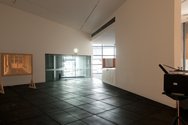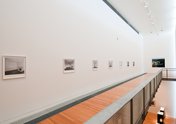Mark Amery – 11 November, 2010
'Long Live The Modern' is balanced to some degree here by the Adam's astute commissioning of three artist projects for the gallery's other spaces. These make a start at grappling with our contemporary relationship to what is a substantial cultural heritage, and echo a similar programming decision at the Adam in 2000, when Gavin Hipkins' 'The Habitat' and Ann Shelton's 'Abigail's Party' were commissioned. I'm left wanting more.
Wellington
Designs for Living:
(Long Live the Modern: New Zealand’s New Architecture, 1904-1984
Mladen Bizumic: From Cube To Ball (Chapter 2)
Lisa Crowley: National Projects
Louise Menzies: Letters to Students of the Radiant Life)
23 October -17 December 2010 / 25 January - 6 March 2011
Long Live the Modern is a terrific book, one that chronicles with love and attention to detail, New Zealand’s modernist architectural history, concrete slab by slab. I regularly paw over its generous black and white photography in my former state house home.
The exhibition by comparison, organized by Gus Fisher Gallery and placed in the bottom gallery at the Adam, is a disappointment. Illustrative in its arrangement, it focuses in on a few select key buildings, yet one of the great strengths of the book is its breadth (the Bulls water tower being a particular personal favourite). The accompanying models here meanwhile only make me long for the detail and life of the actual weathered buildings in situ.
This is balanced to some degree here by the Adam’s astute commissioning of three artist projects for the gallery’s other spaces. These make a start at grappling with our contemporary relationship to what is a substantial cultural heritage, and echo a similar programming decision at the Adam in 2000, when Gavin Hipkins’ The Habitat and Ann Shelton’s Abigail’s Party were commissioned. I’m left wanting more.
The Adam’s continued problem is how to get the kind of audience numbers up the hill to Victoria University to justify the intelligent spare use of the gallery with artist projects. Without this it becomes rather austere, providing its own kind of modernist brutalism.
Louise Menzies’ project is welcome for the performance it invites from visitors. It highlights as a parallel to the modernist impulse in architecture a concurrent but less documented movement concerning the body and mind. Letters to Students of The Radiant Life draws on the work of Havelock North based psychologist Herbert Sutcliffe, whose School of Radiant Living between the 1930s and 70s gained a strong following. A precursor to the holistic health practices that were to become more widespread, Sutcliffe provided a Home Study Course on ‘self development and mental efficiency’.
Menzies reproduces an advertisement for the course on hoardings, as if this might be a temporary site for one of Sutcliffe’s lectures and some group physical exercises. ‘Learn to be receptive to new ideas!’ runs one part of the benefits. ‘Secure health, happiness and success!’
There are interesting correlations here with our current more mainstream self-help culture, the modernist building programme of its time, and the potential role generally of art to be promoted as providing for the advancement of mental health. Could now some course be set up - the work almost comically suggests - to train the public’s minds on overcoming their challenges in regards to the ideas espoused by contemporary art?
On entering the gallery the attendants screen a film for you of some naked meditative physical exercises being undertaken by a young woman on the old colonial balcony of Peloha, the school’s old Havelock North base. It’s as if readying you to disrobe and join in, in the otherwise empty floor space. The old film projector whirrs an old black and white cine film, leaving it ambiguous whether filmed recently or back in the day. The set of movements are slow, elegant and sculptural - a kind of physical drawing in the gallery context of architectural space, and reminiscent of many of art history’s classically proportioned figurative moments.
An accompanying pamphlet is less successful, mimicking one of Sutcliffe’s newsletters but containing a too brief essay musing on Peloha now (home of Weleda) - a more substantial book project is due in March next year. I missed the letters and conversations of those who were students of the ‘Radiant Life’ that Menzies’ title for the project suggests.
The play with time in this work is also felt strongly in Lisa Crowley’s National Projects, the first part of a larger photographic project. Along one wall are seven recent black and white images of the living room interiors of state houses, emptied of furnishings bar the standard fittings of old curtains, light fittings, wardrobe hangers and power points. They await your inspection.
The work takes the matter of fact impersonal point of view of the documentarian but then powerfully twists it. These interiors are all different from each other, yet unnervingly the same. (At first I wondered whether Photoshop had been at play.) Their location is unattributed, and they look in 2010 much as they might have in 1970. These well-made internal structures have endured and, stripped of all else, we see them as utilitarian constructions for providing shelter and warmth (the fireplace hearth and ceiling light fitting are common motifs).
This connects nicely to a large colour photograph placed at the far end of the gallery, mimicking touristic postcard photography of the Maraetai Dam, an impressive 1952 hydroelectric project. The image feels like it could sit framed on the walls of any one of these homes. The work as a whole pays tribute to the significance of these post-war state power and state housing projects to our national infrastructure today.
I love the fresh complexities of the perspective of these photographs. Unlike the real estate industries images they don’t sell the desirability of lifestyle, but rather promote utility. Scrubbed clean, they are empty of the social particularities of the photography of the likes of Aberhart, Ross and Amituanai, yet through visible wear and tear document their history. As photographs they operate in a unique space.
Vienna-based Mladen Bizumic’s engagement with modernist architecture has been an ongoing project. His practice shows a long standing interest in overlaying different geographical sites, cultural modes and psychological states to explore the contemporary malaise of cultural displacement many feel in their lives. Here he’s the perfect artistic foil to the flatness of the Long Live the Modern exhibition.
It’s a pity that his multilayered project here is shoehorned as labyrinth into the small dark Kirk Gallery, when it could respond to the light and exterior life coming through the Adam’s upstairs windows. As a series of small dark passages and rooms it felt unnaturally compressed.
Bizumic states his inspiration partly as one evening passing Viennese emigre Ernst Plishke’s Sutch house in Brooklyn (Wellington), observing as the shadows lengthened and he heard the evening bird song a “modernist house that was part of its environment but at the same time in tension with it. This tension resulted in the house’s structural concept and imbued it with a sculptural quality that seemed rather rare.”
With a range of collaged and layered signifiers Bizumic explores ways to respond to this tension and contemporary life of both the Sutch house and his Dixon Street flats. At the entrance you pass by two precision European clocks their hands trapped by primary coloured blocks that at once evoke Mondrian and cube arrangements in Plishke’s work. Time is being complicated.
In the first chamber there is a wind chime that plays ‘Rock Dove’ (a releasing of the melodic lines in a cube), with modernist hexagonal components and a bird’s feather stuck into it. It is joined by several canvases that see Bizumic collages of the Sutch house placed in Milan Mrkishich-like colour fields and arrangements. I find this a little messy and fussy, but the photo collages themselves are wonderful, a disruption of the modernist harmony of lines and shadows which remain beautiful, like streams of bubbles of thought. The best work in fact here for me is a double slide show of Bizumic’s collages. Made of Plishke architectural details, Bizumic creates organic sculpture out of them to complement the buildings and bring them contemporary life .
Generally however the installation felt too incoherent and fragmented, as if caught between a rare showing in Wellington of different aspects of Bizumic’s current practice and the subject at hand. I wanted a stronger consideration of the personal displacement of both artist and architect between Vienna and Wellington, and more echoes of the tension between the strident modernism Plishke introduced and the city they were placed in.
Mark Amery









 Two Rooms presents a program of residencies and projects
Two Rooms presents a program of residencies and projects Advertising in this column
Advertising in this column



This Discussion has 0 comments.
Comment
Participate
Register to Participate.
Sign in
Sign in to an existing account.